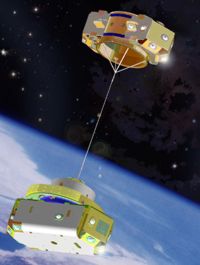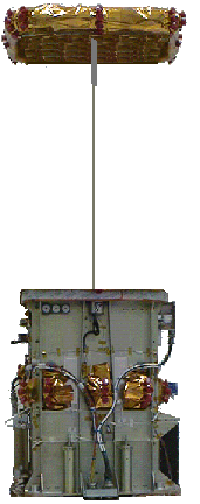
TiPS
Jump to: Mission Objectives, Mission Instrumentation, Mission Parameters, Additional Information
Mission Photos:
 Courtesy of NRL SED |
 Courtesy of NRL SED |
Mission Objectives:
The Naval Research Laboratory's (NRL's) Naval Center for Space Technology designed, built and deployed the first in a series of small satellites to research the gravity-gradient dynamics and survivability of a tethered system in space, known as the Tether Physics and Survivability (TiPS) experiment. TiPS consist of two end masses separated by a four kilometer tether. The end masses were named Ralph and Norton after Ralph Kramden and Ed Norton from the 1950's Television Show "The Honeymooners", respectively. Ralph and Norton weigh 37.7 and 10.8 kilograms, respectively.
TiPS is among the first successful tether deployments in space and is the first experiment designed for long duration. The TiPS tether, made by AlliedSignal, is in two layers. The outer layer is Spectra 1000 braid for strength, the core is acrylic yarn which will puff the other braid out to the 2 millimeter diameter and give it a larger cross section to improve its resistance to debris and small micrometeoroids. The tether could be severed by a space particle as small as 1-mm traveling at a relative velocity of 14 km/s (31,318 mph).
Advanced Tether Experiment (ATEx) was the follow-on mission to TiPS and was launched on 03 October 1998. ATEx was a payload carried by the Space Technology Experiment (STEX) spacecraft. ATEx consisted of an upper end body, a 6,050 m tether, a lower end body, an interface deck, and the STEX spacecraft. ATEx also carried a corner cubes for satellite laser ranging, which would have been used in precision orbit determination. The main ATEx mission objectives were:
- Demonstrate tether system stability andcontrol
- Demonstrate end-body attitude determination and control
- Fly a tether designed for survivability
Mission Instrumentation:
TiPS had the following instrumentation onboard:
- Telemetry system located on Ralph
- Turn-count recorder located on Ralph
- Temperature sensors located on Ralph
- Retroreflector arrays on both Ralph and Norton
ATEx had the following instrumentation onboard:
- GPS receivers
- Retroreflector arrays
Mission Parameters:
| TiPS | ATEx | |
| Sponsor: | US Naval Research Laboratory | US Naval Research Laboratory |
| Expected Life: | 6 months, SLR support was discontinued on September 30, 1997 | unknown |
| Primary Applications: | tether physics | tether physics |
| COSPAR ID: | 9602902-Norton, 9602903-Ralph | 9805503 |
| SIC Code: | 6001-Norton, 6002-Ralph | TBD |
| Satellite Catalog (NORAD) Number: | 23937-Norton, 23936-Ralph | 25615 |
| Launch Date: | June 20, 1996 | October 3, 1998 |
| RRA Diameter: | n/a | n/a |
| RRA Shape: | n/a | n/a |
| Reflectors: | 18 corner cubes per end mass | 43 corner cubes per end mass |
| Orbit: | circular | circular |
| Inclination: | 63.4 degrees | 85 degrees |
| Eccentricity: | 0.001 | 0.000 |
| Perigee: | 1022 km | 787 km |
| Period: | 106 minutes | unknown |
| Weight: | 54 kg | 53 kg |
Additional Information:
- TiPS at NRL (Projects, Spacecraft Engineering Department)
- ATEx at NRL (Projects, Spacecraft Engineering Department)




